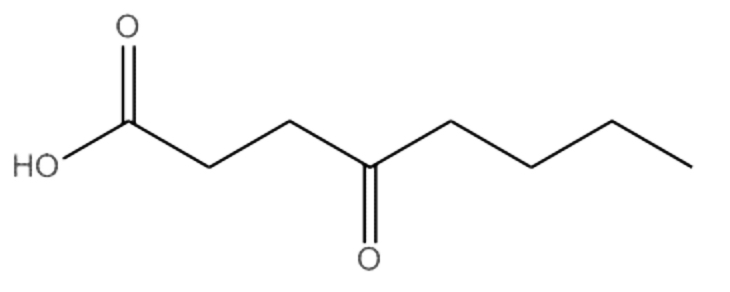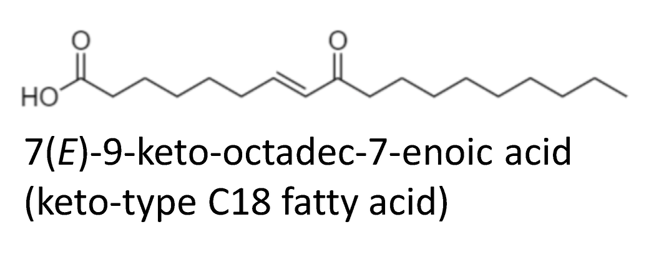
Keto fatty acids (or oxo fatty acids) are rare but one is well known, 9-keto-2t-decenoic acid, which is an active constituent of the royal jelly (milky substance produced by the worker honey bee).

This fatty acid which has also a pheromone role, is produced by the mandibular glands of the queen, it attracts and controls the activities of the workers in suppressing the queen-rearing behavior of the worker bees. Several other examples of similar chemicals participate in animal chemoreception (Winston M et al., Am Scientist 1992, 80, 374). More recently, it has been demonstrated that 4-keto-octanoic acid and 4-keto-decanoic acid are the major pheromone compounds in the Asian hornet Vespa velutina, native to inland China but having invaded several other parts of the world where it causes harm to local apiculture industries by preying on honey bees. These molecules were shown to be potent for attracting males, thus being a useful general tool in efforts to control invasive hornet populations (Cheng YN et al., Entomologia 2022, 1395).

4-keto-octanoic acid
9-Keto-2-decenoic acid could be a stimulant of the antibiotic activities against harmful bacteria and fungal infestations.
9-Keto-7-hexadecenoic acid and 9-keto-10-hexadecenoic acid are two isomeric keto-fatty acids derived from the marine algae Chaetoceros karianus that were found to exhibit dual PPAR α/γ agonist activity and also regulate vital PPAR target genes in hepatocytes and adipocytes. Whole transcriptome demonstrates that they induce antidiabetic gene programs in adipocytes by upregulating insulin-sensitizing adipokines and repressing pro-inflammatory cytokines (Saether T et al., Eur J Med Chem 2018, 155, 736).
A new keto fatty acid, 9-keto-13-octadecenoic acid was isolated from the seed oil of Smilax macrophylla (Liliaceae) (Daulatabad CD et al., Phytochemistry 1996, 42, 889). Rosaceae are characterized by some unusual fatty acids, among them the triunsaturated licanic acid, 4-keto-9c11t13t-octadecatrienoic acid, which was described for the first time in oiticica oil extracted in Brazil from Licania rigida (Brown WB et al., Biochem J 1935, 29, 631). This keto derivative of eleostearic acid is present at high concentration (about 60%) in Licania seed oil (Mendelowitz A et al., Analyst 1953, 78, 704). This oil is used as a drying oil for varnishes, and as a component in the manufacture of alkyd resins.
During the isolation and evaluation of the antimicrobial activity of Streptomyces metabolites active against phytopathogens, a new ketonic acid, streptoone B was isolated from Streptomyces sp. SN0280 (Tian H et al., J Nat Prod 2017, 80, 1015).
Three long-chain keto fatty acids have been reported at levels from 3 to 13% in the seed oil of a Bignoniaceae Cuspidaria pterocarpa : 15-keto-18-tetracosaenoic, 17-keto-20-hexacosaenoic and 19-keto-22-octacosenoic acids (Smith CR, Lipids 1966, 1, 268). The seed oil of a Papaveraceae Argemone mexicana was shown to contain about 1% of 9-keto- and 11-keto-octacosanoic acids, and a 30 carbon chain keto fatty acid, 11-keto-triacontanoic acid (Gunstone FD et al., Chem Phys Lipids 1977, 20, 331).
The isolation and structure elucidation of an unusual fatty acid with γ-oxocrotonate partial structure have been described (Teichert A et al., Z Naturforsch 2005, 60, 25). That compound revealed fungicidal activity against the ascomycete Phytophthora infestans, the causal agent of potato and tomato late blight disease. That ascomycte is known as one of the most destructive pathogens worldwide (Eschen-Lippold L et al., J Agric Food Chem 2009, 57, 9607).

(2E)-4-ketohexadec-2-enoic acid
It has been found that a ketol derivative of linolenic acid, 9-hydroxy-10-keto-12(Z),15(Z)-octadecadienoic acid, is a signal compound in Lemna paucicostata after exposure to stress, such as drought, heat or osmotic stress (Suzuki M et al., Plant Cell Physiol 2003, 44, 35). That compound reacts with catecholamines to generate products that strongly induce flowering (Yokoyama et al., Plant Cell Physiol 2000, 41, 110; Yamaguchi et al., Plant Cell Physiol 2001, 42, 1201).
A new keto acid, 12-keto-5,8,10-heptadecatrienoic acid, is produced (together with 16:4n-3) in mesenchymal stem cells treated by chemotherapy products and was shown to be related to the induced resistance after treatment. The formation of that keto acid, through the action of cyclooxygenase-1 and thromboxane synthase, could be a target to enhance chemotherapy efficacy in patients (Roodhart JML et al., Cancer Cell 2011, 20, 370).
A keto-type C18 fatty acid (7-9-keto-octadec-7-enoic acid) from an edible green alga, Ulva lactuca, could increase the expression of cytoprotective genes regulated by the antioxidant-response element (ARE) (i.e., NADPH:quinone oxidoreductase 1, heme oxygenase 1, thioredoxin reductase 1, glutamate–cysteine ligase subunits, and the cystine/glutamate exchange transporter). The ARE-activation effect of the compound and the consequent induction of the ARE-controlled gene expression were also observed, in vivo, in mice models (Wang R et al., Free Radic Biol Med 2013, 57, 141).

A 20-carbon keto acid, 15-ketoeicosatetraenoic acid, was discovered to be attached to phosphatidylethanolamine found in monocytes and macrophages (Hammond VJ et al., 2012, 287, 41651). It was shown that that compound is able to activate peroxisome proliferator-activated receptor-g.
Devenez membre et participez au développement de la Lipidomique au XXIème siècle.
S'inscrire